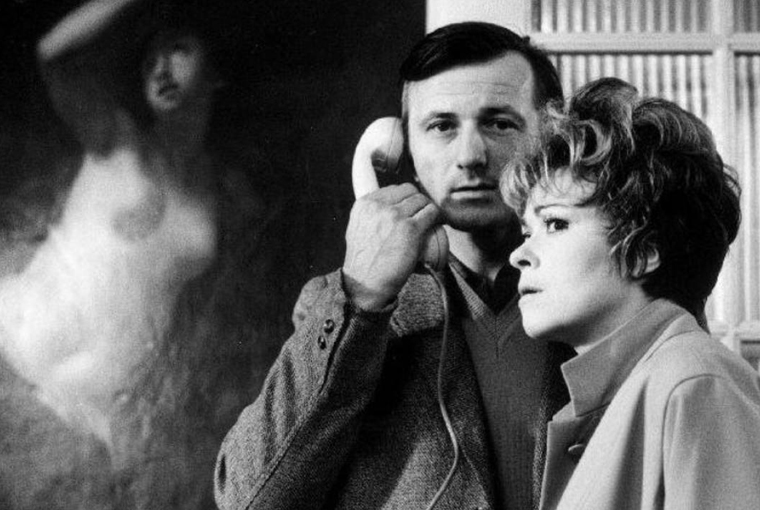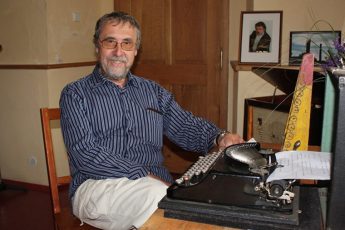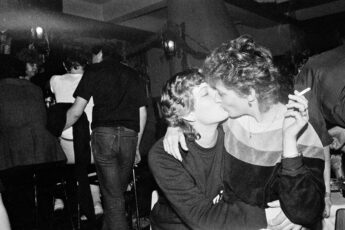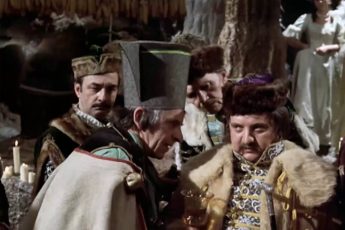Conscience and the Subjective Camera
Karel Kachyňa’s The Ear (Ucho, 1970)
Vol. 20 (August 2012) by Julia Zelman
The Ear is one of the most politically incendiary films to emerge from the Czechoslovak Young Wave. Finished in 1969 — after the Prague Spring uprising and the invasion of Soviet tanks — it was locked away for twenty years upon release. Only in 1990 was it seen at the Cannes film festival, where director Karel Kachyňa was nominated for the Palm d’Or. In the past few years, it has become possible to see the film on DVD in Western Europe; this year, Czech film enthusiasts in the United States can at last rejoice in its availability on Hulu. A reappraisal of this extraordinary last-minute attack on totalitarianism before the “normalization” period is due.
The history of postwar Communist Czechoslovakia allows for political interpretation of a wide range of films. Because of the ideological strictures placed on artists by totalitarian regimes, any rebellion against aesthetic norms can be seen as subversive expression. But as scholars such as Dina Iordanova and Jonathan L. Owen have observed, the films of the Czechoslovak Young Wave have been oversimplified by critics’ over-emphasis on political interpretation. In Owen’s words, the diverse currents of the movement are “regarded either as a conduit of official discourse, or as a forum for critique and dissent.”1
Certain filmmakers, even so, can stake a strong claim to the role of socio-political critic. Their films portrayed politically fraught subjects such as war, Party hierarchy and collectivisation. Some of these directors came from the younger generation of the Wave — Evald Schorm, a master of both ferocious satire and dark existential drama, provides one example. However, some of the most courageous anti-authoritarian gestures came from the older directors, the so-called “Generation 1957,” and included the films of Karel Kachyňa, Vojtěch Jasny, and Frantisek Učil, among others. An analysis of The Ear will, I hope, demonstrate how an innovative aesthetic approach is inseparable from the film’s politically complex message.
The team of Kachyňa and writer Jan Procházka created several of the most controversial of Generation 1957’s films. Both men were able to venture into dangerous territory in part because of their relatively privileged positions. Kachyňa was among the pioneer filmmakers of the Young Wave. He, along with Jasný and Zdeněk Podskalský, graduated from FAMU (the Prague Film Faculty) in the late 1950s.2 Procházka’s story is one of the better-known tragedies of the Prague Spring: once an untouchable friend of Antonín Novotný, he was banished from the Party after his involvement with dissidents during the protests and died of cancer in 1971. But for a time, his friendships and credentials as the head of the ideological office at Barrandov Studios allowed him extraordinary liberty of expression. Long Live the Republic! (At’ žije republika, 1965) portrays the last days of World War II from the nonpartisan point of view of a downtrodden young boy whose adult friend, accused of collaboration with the Germans, drowns himself in a well. The Nun’s Night (Noc nevěsty, 1967) baldly portrays the coercive tactics used to force reluctant landowners to join agricultural collectivisation. Even more shockingly, as Jan Bernard points out, the film dares to show the onscreen attempted murder of the village’s hated Communist.3
The Ear, shot from Procházka’s last and bitterest screenplay, acquired something of a legendary status during its long imprisonment in the archives. The Ear’s protagonist is a Party bureaucrat named Ludvík who, during the course of a soiree in the 1950s, becomes convinced of his impending arrest in a political purge. After the party, he and his wife Anna bicker, panic, and nearly break down in their home, where they find that their electricity has been cut, strangers have been through their house, and one room after another proves to be bugged.
The creation and suppression of The Ear were political events in themselves, and the film refers fearlessly to many taboo subjects of the Stalinist era: Party debauchery, anti-Semitic arrests, favoritism and corruption. But as courageous as is the film’s content, it should not overshadow Kachyňa’s innovative style. The film alternates scenes of the couple at home and flashbacks showing their increasingly sinister evening at the Party soiree. These flashbacks make extensive use of subjective camera from Ludvík’s viewpoint as he tries to find out why the minister he works for, Košara (né Karpeles — a Jewish name), has been arrested, and whether he himself might be next. While this subjectivity may not necessarily have been new to the Czechoslovaks, and experiments in “I” camera can be found in the works of, among others, Pavel Juráček and the Slovaks Juraj Herz, Stefan Uher, and Juraj Jakubisko, the first-person viewpoint in The Ear is remarkable for its emphasis on the question of conscience and guilt. The camera alternates between embodying Ludvík’s growing terror, adopting his perspective as he wanders feverishly through the soiree looking for answers, and a more objective style at the couple’s home as Anna attacks him for his cowardice and opportunism. But the more subjective and more distanciated parts of the film alike put Ludvík’s relative innocence to the question.
Like other protagonists in the more politically explicit Young Wave films (The Joke [Zert, 1969] and Everyday Courage [Každy den odvahu, 1964], for example), Ludvík is a man who begins as a Party member and finds himself shut out of the system he helped run. His moral status as a victim is therefore far from clear-cut. During the scenes at the party, the camera lingers constantly with him, parceling out information to the audience and Ludvík at the same time. It is difficult not to experience his dread and uncertainty. Yet the camera does not allow us to identify with him completely.
One twice-repeated shot sequence exemplifies the complexity of the play of point-of-view during the soiree scenes. Ludvík is framed in a medium close-up, seemingly staring at the lens. An off-screen woman’s voice cries his name and announces that Anna is looking for him. Ludvík turns as the camera pans right and pulls focus, and we realize that in fact we had been seeing his mirror image. Now the real Ludvík is once again facing us, staring into the lens. He advances, looking dazed. A hand-held shot shows what Ludvík sees as he stumbles amidst the party-goers, coming finally to rest on the exuberantly drunk Anna. In these two shots, the audience goes through several changes in relation to the protagonist: first, without realizing that we are seeing a mirror image, we seem to be confronted with Ludvík’s gaze directly. When he turns, we notice that we have been looking through his eyes, intruding upon his self-scrutiny in the glass. In other words, what we thought was presented as direct reality is mediated through the character’s gaze. But this pan also dislodges us from this point-of-view and allows us our own, unfiltered examination of the man in close-up. Instead of allowing us to identify with a persecuted hero, Kachyňa’s camera jerks us free of Ludvík’s subjective state in order to see the man himself.
The same structure plays out in the entire film. For a long time, the camera and screenplay privilege Ludvík. The flashbacks to the party slowly reveal that he is in a state of terror while Anna rails, drunk, angry and oblivious to all but the fact that her husband has forgotten their anniversary. The intrusion of the brightly-lit, chaotic soiree images amidst the sinister candle-lit scenes at the house reflect Ludvík’s frenzied efforts to reconstruct the evening as evidence mounts that the house has been searched. As the film progresses, though, Ludvík looks less and less like an innocent. His memories of the evening show him denying his close friendship with Košara, even secretly tearing up a photo of them together and flushing it down the toilet. A pivotal moment reveals the protagonist’s still uglier side: when a group of drunken thugs invade the house in the middle of the night, not to arrest him but to continue carousing, he welcomes them in relief and lets them despoil his refrigerator and liquor cabinet. At this point, the film flashes back to a moment at the party, wherein Ludvík hides from his wife with the thugs in private lounge as they reminisce — or invent stories—about “the war.” Back at his own house, no amount of loutish behavior from the “guests” earns a reproach from him. Even when the ringleader cheerfully explains that night that they have just been searching the house of Klepač, the arrested man next door, Ludvík joins in their phony camaraderie.
This sequence changes the tone of the film for two reasons. First, of course, it portrays the flip side of brute force and intimidation in a totalitarian society: the selfish and nearly hysterical relief of the man who has been arbitrarily spared. This excitement manifests itself in debauched drinking, gluttony and buffoonery. Second, the moral center of the film shifts to Anna, who is so disgusted at her husband’s behavior that she repulses his sexual advances and accuses him of cowardice and betrayal: “While [Košara] is locked up, they come here to live it up with you.” Soon, tormented by Ludvík’s complacency now that he feels safe, she drinks herself into a rage and confronts him with all his crimes, as a bureaucrat and as a husband, from their past ten years of marriage.
Anna’s sudden taking-up of the role of conscience shifts the center of the film. The question is no longer, “Will Ludvík fall victim to the regime?” but “Why does he cooperate so cravenly the regime?” Cynical, alcoholic, self-loathing and disappointed, Anna knows only too well that a lack of political integrity spills into private life. He married her, she laments, only for her father’s money, and she has seen him kowtow to everyone from President Beneš onwards. But her change from discontented wife to voice of truth does not come as a complete reversal in the film. For one thing, as noted, even the flashbacks which seem to mimic Ludvík’s recent memories are not strictly from his perspective, but occasionally—and jarringly—deviate from his gaze, creating a distance from his emotions. Second, rather than switching from Ludvík’s perspective to Anna’s, the film becomes aloof from both of them. A curious shot of Anna smoking in the kitchen, rallying to attack her husband’s indifference, shows her from a low, wide-angle that emphasizes the size of the room and diminishes her small, pajama-clad body. At almost no point do we see through her eyes. At one moment, Ludvík desperately tries to silence her by hitting her, then holding her head under a faucet. Her bloodied face is almost painful to look at in its misery and vulnerability even as she continues her furious protests.
Ludvík’s efforts at patronizing dismissal — “Do I ask you about your pans?” — try to confine totalitarianism to the masculine realm of work. But Anna persists in seeing Košara and the others’ arrests as a matter of ethics. Unquestionably, she retains the moral high ground. By avoiding the first-person camera from her point of view, the film stresses that her grievances are not merely personal. Her questions — “Why did you give [the thugs] the cake?” “They must have told you something about why they put [Klepač and Košara] away. Didn’t you ask them anything?” — strike at the moral problem facing the passive subjects of a dictatorship. Even the seemingly trivial question about the cake hints at the acid of political paranoia eating into the health of a domestic relationship.
But if Anna acts as a balance to her husband’s weakness, she remains merely human, with limited power to change the course of events. The erotic woman sometimes appears in Young Wave films as a symbol of subversion of totalitarian order. The Czech Jiři Menzel for one used this theme recurrently: in Closely Observed Trains (Ostře sledováne vlaky, 1966), the Resistant “Viktoria Freie,” inspires the hero to feats of manly self-sacrifice by taking his virginity; in Larks on a String (Skřivánci na niti, 1969), male and female political prisoners in a work camp brave Spartan punishments in the pursuit of love and sex. While, as Peter Hames notes, the “association of sex with the theme of national liberation” was one of the most shocking elements of the film, these films have a tendency to reduce women to a symbolic function.4 Jonathan Owen is correct in pointing out that “for all its artistic sophistication the role that [Closely Observed Trains] offers its female characters is little better than that of a sex object”5; the same could apply to other Young Wave Films. Women in the Viktoria Freie model have what Hames calls a “magical quality” that removes them from the realm of immediate experience.6
Anna in The Ear is the antithesis of these symbolic, erotic women. She is at her strongest when denying her sexual side: though anxious to go to bed with Ludvík at the start of the film, after the lull following the thugs’ pillage, she pushes him away in disgust. During her tirade against her husband, she screams that he only married her for the dowry her father was forced to offer to marry off his “little whore.” She has vented her frustration with the marriage by sleeping with various younger men. Excessive sexuality is a symptom of dissolution and helplessness, not a source of strength. One might say that, contrary to Viktoria Freie’s nearly inhuman, inspiring charm, Anna’s sexuality is not larger or more powerful than her faults as an ordinary person.
This refusal to romanticize the female voice of conscience leads the film to a bleaker, more realistic but perhaps more human conclusion. When the couple suddenly realizes that several electronic ears in the nursery, bathroom and kitchen have been recording their highly compromising conversation, Anna’s rage turns once again to fear for her husband’s fate. Ludvík, meanwhile, resigns himself once again to his impending downfall. Now that roles have been reversed, the couple comes together in numbed tenderness.
When a despairing Ludvík shuts himself in the bedroom, the camera remains with Anna as she hammers on the door, pleads with him not to kill himself, and finally climbs out the on the second-floor ledge to smash the window. But her attachment to him and her courage do not save him. It is rather the fact that the authorities have discreetly confiscated his gun that prevents him from harming himself. “When they want to do it, they do it themselves,” he murmurs. He remains dazed and unreachable. Anna’s determination does not waver: “I won’t let you go […] They can lock me up too.” Anna’s strong will compels her to defiance even if the two are helpless pawns in the hands of the state bureaucracy. As soft, almost romantic music plays on the soundtrack, the woman, framed in extreme close-up, cries, “What are we? Still human beings? What do you want? What do you want, ear? Do you want us to kill ourselves?” Her protest serves two paradoxical functions: to valorize her stubborn humanity, and to underline its futility.
The film’s conclusion emphasizes this helplessness. Ludvík at last receives a telephone call at five a.m. He at first mistakes it for the fateful doorbell announcing the secret police. It is, in fact, the President informing him that he has just been named minister in Košara’s place. The reprieve provokes no exuberance this time. Husband and wife sit side-by-side in exhaustion. The low-wide angle recalls the shot of Anna smoking in the bathroom during the fight. A large Renaissance-style painting of a half-nude woman flanks them: a reminder, perhaps, of the idealized, erotic woman so absent from this bitter realist film. Anna says, “Ludvík, I’m scared.” They sit in silence and the shot fades to black. The final shot, then, retains this distance from the subjectivity in which the film began.
The deviation of the film from a partially first-person narrative to a mostly aloof camera grants The Ear an interesting position in the Young Wave. According to Petra Hanaková, scholars have historically distinguished between “moralistic” and “formalistic” currents of the movement, a designation not adequate to describe such vital films as Daisies (Sedmikrásky, 1966) or, indeed, The Ear.7 Peter Hames hits closer to the mark in contrasting the “critico-realist” and “lyrical” branches8, while Petr Král divides the movement into “moralistic,” “lyrical (subjective),” and “critical objective”9 films. The Ear combines a certain didacticism (a condemnation of cowardice and opportunism) with an absurdist spirit (the final shot, with the nude painting) and the briefest moments of emotional lyricism (the sinister party scenes, Anna’s plea to her husband).
The Ear is therefore significant not only for its historical status as a protest, but also for its confounding of the usual categories assigned to Young Wave film. It further shows that the Generation 1957 filmmakers, while certainly stimulated by their juniors in the movement, boasted talents that they could only really exercise during brief heyday of free speech. As Dora Viceníkova asserts, Kachyňa’s (and others’) talent attests that “the republic’s most famous film era is a logical progression of Czechoslovak cinema language rather than an offshoot of the political changes” surrounding the Wave.10 Ultimately, The Ear provides an argument for regarding the Wave as an opportunity for cinematic innovation, not only a flowering of cultural protest.




Leave a Comment